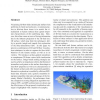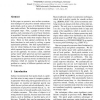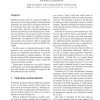109
Voted
VMV
2008
15 years 1 months ago
2008
Visualizing 3D flow fields intrinsically suffers from problems of clutter and occlusion. A common practice to alleviate these issues is to restrict the visualization to feature su...
107
click to vote
VMV
2008
15 years 1 months ago
2008
In this paper we present a new surface reconstruction technique for piecewise smooth surfaces from point clouds, such as scans of architectural sites or man-made artifacts. The te...
VMV
2008
15 years 1 months ago
2008
Recently it was observed, that a combined formulation of tracking and reconstruction increases the robustness and accuracy of both these steps in structure-from-motion problems [9...
78
Voted
VMV
2008
15 years 1 months ago
2008
We propose an adaptive decomposition algorithm to compute separation distances between arbitrarily shaped objects. Using the Gilbert-JohnsonKeerthi algorithm (GJK), we search for ...
111
Voted
VMV
2008
15 years 1 months ago
2008
We present in this paper a novel object tracking system based on 3D contour models. For this purpose, we integrate two complimentary likelihoods, defined on local color statistics...
77
Voted
VMV
2008
15 years 1 months ago
2008
In this paper we discuss generalizations of instantaneous, local vortex criteria. We incorporate information on spatial context and temporal development into the detection process...
116
Voted
VMV
2008
15 years 1 months ago
2008
Architectural blueprints offer a concise, clear and high-level description of the structure of a building. On the other hand, state of the art reconstruction pipelines can nowaday...
96
Voted
VMV
2008
15 years 1 months ago
2008
Bounding volume hierarchies have become a very popular way to speed up ray tracing. In this paper we present a novel traversal and approximation scheme for bounding volume hierarc...
92
Voted
VMV
2008
15 years 1 months ago
2008
Scientific data-sets often come with an inherent hierarchical structure such as functional substructures within organs. In this work we propose a new visualization approach for vo...
94
Voted
VMV
2008
15 years 1 months ago
2008
Machine learning with few training examples always leads to over-fitting problems, whereas human individuals are often able to recognize difficult object categories from only one ...



